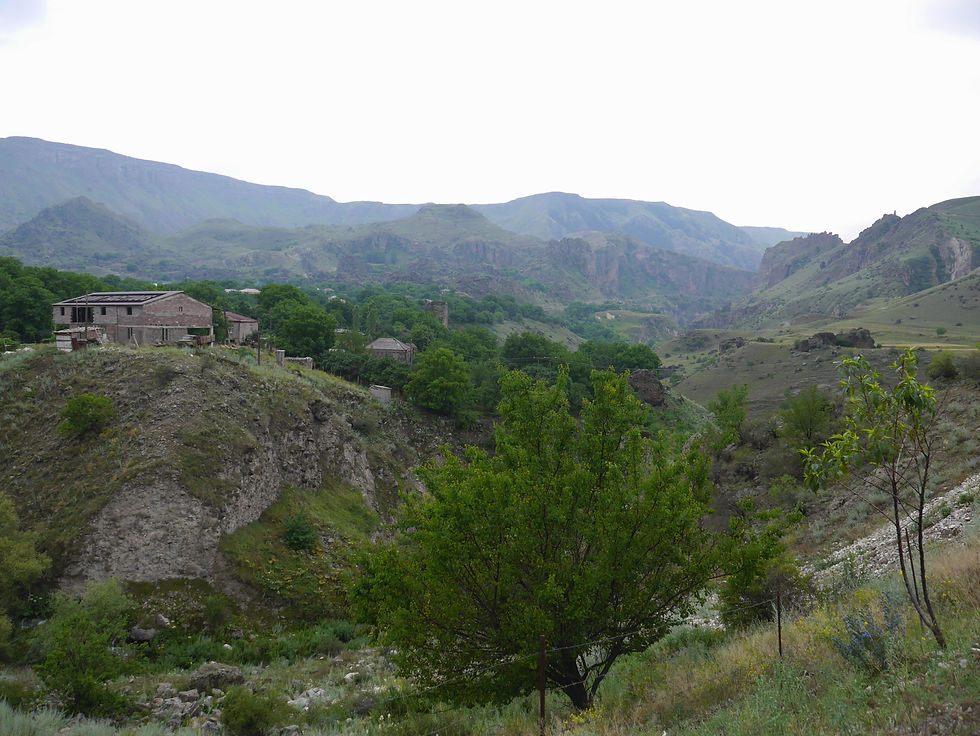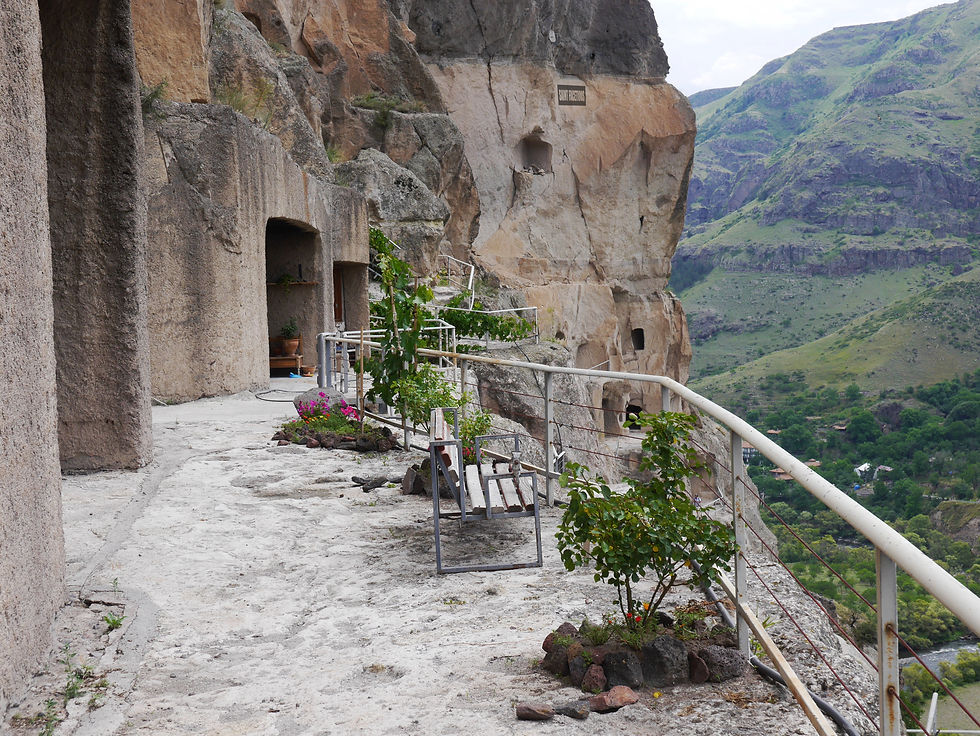- Shawn Basey

- Sep 29, 2019
- 5 min read

It was once a pile of crumbling ruins on the hill of a sad metropolis. Always grey skies, or raining, or if not that then sunny, hot, and dusty. Then one day someone had a grand vision to rebuild it all and make a wedding house out of it, somewhere nice for the locals of Akhalsitkhe to take fancy pictures and maybe not have their celebration in some hotel that for the rest of the year serves as a brothel or a refuge for very lost tourists.
That is, I guess, how Rabati came to be.
And why not?
I’ll admit I’ve been a detractor myself. But what was once there before was hardly a useful place to bring tourists, and now that I’ve been to Rabati with bright-eyed tourists not yet bogged down by the cynicism of thousands of liters of wine, I’ve grown to appreciate the site myself.

entering Rabati
A bit of history
The grounds here are fertile with history, and though what has bloomed is nothing but a complex of hotels, meeting rooms, and Instagram-perfect portrait studios, it’s still something beautiful where there was only the vague remnants of grey stone. And to their credit, they took some effort to restore the semblance of the great castle and citadel that once stood there. So why not indeed?

Come for the castle, stay for the "Gino paradise", whatever that means
What stands now as Rabati Castle was first built by Georgians as Lomisa Castle in the 9th century and by the 13th century was the capital of the Principality of Samtskhe, ruled over by the House of Jakeli. Here Queen Tamar often stayed, commanding her legions against the Turks, sending out her husband-consort David Soslan to crush the Turks at Bassiani and secure a hundred years or so of peace and prosperity for the Georgians.

Those golden years would end with Tamerlane and his “Mongols” riding in and devastating any land that would stand against him. In 1393, Lomisa finally fell. The fortress carried on nominally independent but mostly under Persian Safavid rule, a dismal reminder of what glory there had once been, until finally it was ceded to the Ottomans in 1590.
The Ottomans completely redesigned the castle. A medieval city within the curtain walls (now something of a park and restaurant/hotel complex) led up the stairs to the actual castle, itself having two more layers. There was the outer layer, which held the mosque and an Islamic school (and an Orthodox church that managed to peter on through the Ottoman regime, good news for all those weddings), and the further interior containing the citadel, where the regional governor would have lived and also where the dungeon was (and in the case of an invasion, the site of a last stand for the castle).

The mosque, freshly restored during the renovations (but only as a museum... until Hagia Sophia is restored!)
The Ottomans were constantly banging heads with the Romanovs, as the Turkish and Russian empires shared a very long border, from Crimea down to Armenia, tearing the Georgian territories into numerous parts. The Russians, for their part, were at least gluing some of those bits together under their own sovereignty, and in 1810 launched an attack to claim Samskhe-Javakheti, which meant confronting the Ottomans at Rabati. The Ottomans held up, but finally lost to the combined Russian and Georgian forces under the Russian general, Ivan Paskevich after some 30 years of intermittent fighting.

The old madrasa
It was then largely abandoned and ignored, falling into severe ruin (like most of the string of fortresses in the region), until 2011 when renovations took place (unlike most of the string of fortresses in the region). If you want to get a look at an “authentic” castle, or get a feel for what Rabati once looked like, you can visit Akhalkalaki, about an hour and a half away.

Akhaltsikhe from above

Feeling like a wedding? Just maybe you'll get some better weather...
Now though there are beautiful gardens, a wedding chapel, a history museum, and a citadel, all back and looking as good as new... because they are as good as new. You can walk along the ramparts, explore the entrance tunnels, view the city from above, and see an exhibit of what Meskhetian houses look like (in the citadel).

Heading up to the citadel

The castle gardens... one wonders if it was so beautiful in medieval times...
Getting to Rabati isn't too hard, but it is uncomfortable, as passenger rail no longer goes there from Tbilisi (you can take it as far as Borjomi, then you have to get on a marshrutka, I have no idea when this stopped, but it's clear that there was passenger rail in Soviet times, a period which any train lover gets all teary-eyed). It is, luckily, only a 10 minute walk from the marshrutka station. Akhalsitkhe Marshrutkas leave from Didube in Tbilisi.
If you're driving, note that the parking lot and entrance to the castle is here. At the traffic circle, you'll want to go under the passenger rail bridge.
Not just Rabati
There’s a history museum there. But I recommend anyone visiting to go there before 6 and actually see it. I’ve never been, as Rabati is always my last stop giving tours, first Vardzia, then Khertvisi, then here. If you have the time, Akhalsitkhe is definitely worth visiting for a few days, so to also see all the secondary sites, and here I don’t mean just the history museum, but also 10th century Sapara Monastery (if you haven’t been overwhelmed by churches and monasteries on your visit to Georgia, than perhaps this a tier one sight, better than Rabati), Tmogvi, Vanis Cave Monastery, the old half-abandoned mud-roofed Meskhetian villages, and by extension the megaliths on the other side of the Tianeti Range. But if you have a day you’ve got a day, eh?
There will always be those detractors about Rabati, claiming this or that is not “authentic” enough. Go around half of Europe. You mean to tell me those castles are the least bit authentic?
Where to stay and eat?
I've only stayed in Akhalsitkhe once. It was in a real budget-rate hotel, with an Armenian wedding going on downstairs, and I imagine the place wasn't used for anything savory during the off season. But Akhalsitkhe looks light years better than what I remember it as, and might be even worth a visit. If you've got the money, you can even stay at a luxury hotel within the castle itself: Hotel Gino Wellness. The restaurant across from there is also strangely affordable for being right smack in the middle of the main tourist attraction.

Hotel Gino's internal examination
If you're staying, I recommend eating at Pizza and Cake House at 61 Kostava and ordering a pizza. It's more of a xachapuri/pizza or perhaps a calzone, with the pizza baked into the bread itself. We ordered one set of topping and got another set, so be ready for a surprise. It was delicious though, so I can't argue about what we got.
If you want to eat on the road to or from Vardzia, I'd recommend hitting Cafe Leki, which is about at the halfway point on the highway. Super friendly people, and their entire selection of food is grown and slaughtered by the family, from tomatoes to pigs.
If you don't have a car, then it's easiest to stay in town. If you do have a car, then maybe it's even better to make this trip into two or three nights and base yourself near Vardzia at my favorite place, Guesthouse Tirebi in Aspindza.



































